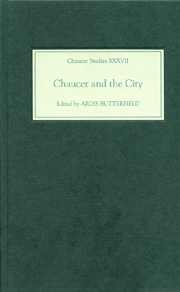Book contents
- Frontmatter
- Contents
- List of Illustrations
- Dedication
- Preface
- List of Contributors
- Abbreviations
- Map
- INTRODUCTION
- LOCATIONS
- 2 Greater London
- 3 The Production of Space in Chaucer's London
- 4 Chaucer's Poetics of Dwelling in Troilus and Criseyde
- COMMUNITIES
- INSTITUTIONS
- AFTERLIVES
- Bibliography
- Index
- CHAUCER STUDIES
2 - Greater London
from LOCATIONS
Published online by Cambridge University Press: 05 February 2013
- Frontmatter
- Contents
- List of Illustrations
- Dedication
- Preface
- List of Contributors
- Abbreviations
- Map
- INTRODUCTION
- LOCATIONS
- 2 Greater London
- 3 The Production of Space in Chaucer's London
- 4 Chaucer's Poetics of Dwelling in Troilus and Criseyde
- COMMUNITIES
- INSTITUTIONS
- AFTERLIVES
- Bibliography
- Index
- CHAUCER STUDIES
Summary
Late Fourteenth-Century London
Chaucer's imagination was steeped in London life and London language. His writings are infused with urban discourses such as curial prose and the legal complaint, and some of his earliest readers were Londoners (most famously Thomas Usk). Chaucer often refers to London geography in a throwaway manner and his poetry sometimes invokes the city in detail of breath-taking vibrancy. His life was, of course, profoundly bound up with London through his family background, his jobs, and his home above the walls. This essay is concerned with investigating what ‘London’ might mean and suggest – both geographically and culturally – in a late fourteenth-century textual environment. In particular, my interest is in the fractured and porous nature of London in the 1380s and 1390s. I suggest that in order to understand Chaucer's intimate involvement with the city we recognise the flexibility of the idea of London at this time. London, for Chaucer and his contemporaries, was not a contained, culturally unified city. Instead, it was a more complicated and expansive location, encompassing court and suburbs as well as the City itself, a place of fluctuating, unfixed boundaries. This geographical diversity was paralleled by cultural diversity. The London that is refracted through late fourteenth-century texts, including those by Chaucer, is a place of cultural conflict, jostling rivalries, and incompatible interests. The city, then, cannot be found in Chaucer's poetry if one seeks a coherent space; rather it emerges as a profoundly split and antagonistic location.
- Type
- Chapter
- Information
- Chaucer and the City , pp. 25 - 40Publisher: Boydell & BrewerPrint publication year: 2006

